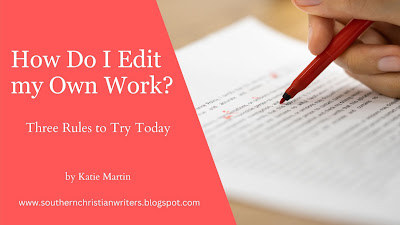Three Rules for Self Editing your Work
One of my college professors once told our class the most mind-boggling piece of advice: when you self-edit, change your font.
I stared at him.
Change the font?
Yes. Change its size, its typeface, its location on the page. Print it out, take it to a different place, and sit down and read it.
I had absolutely never thought about any of those things. When I edited my work, I might print it, but I would stare at the same words over and over again, and edit until the words ran together in a bleary stream on the page.
Changing the font changes everything.
And here is the reason why (along with some other helpful self-editing rules).
Rule 1: Make what you edit look different from what you write.
You have written your piece. You know what it says—or rather, you know what you think it says. How many times have we written a wonderful article, story, or poem, only to read it two months later and say, “Did I really say, ‘the fog’s cloak’ instead of ‘the frog’s croak’?”
When we read what we have just written, we assume that our thoughts have been accurately translated onto the page. Our minds are often still in writing mode, and we skim over the words because we know what we were thinking as we were writing.
We need something to jar our attention.
Changing the font, whether in size, typeface, or weight, helps us to break out of “writing mode” and settle into “editing mode.” The words will be more fresh and unexpected on the page, and you’ll be forced to pay attention to what the words actually say, rather than what you think they say.
(Note: You can also accomplish this by reading your work out loud, or taking it to a different physical location.)
Rule 2: Let it age.
Age is a blessing, is it not? And in the realm of writing, it certainly lends itself well to the editing process. Setting your work aside and letting it age for several days or weeks (or even months, depending on the project) can help you edit it with a fresh look and an outside lens.
You’ll be able to see where your logic might need additional explanation, or where a character might need more dialogue. You’ll also see if your structure might need tweaking, or if some paragraphs would read more smoothly in a different order.
Giving yourself the separation of time and space will allow your mind to bring fresh, creative ideas to the editing process. It can be hard to put your work aside and wait, but giving your writing a sense of rest and completion will bring fruitful results.
Rule 3: Know your genre, and know your grammar.
There are multiple layers to editing, from broad developmental edits to tiny, super-specific grammatical edits. Being a successful self-editor requires that you know the genre conventions of your piece, as well as the technical grammatical side.
Thankfully, there are many resources to help us be sharp editors and excellent grammarians—even if editing is not our most natural strength.
For genres, it is always helpful to read examples from other writers. Perhaps you are writing an inspirational romance novel or a biography. You can check out previously published works from a variety of authors and take note of their writing styles and content. Which ones were your favorites? What set their writing apart? How did they use language to communicate their story?
In addition to reflecting on the genre, you can also brush up on your grammar skills. There are many excellent books and resources on this—you can start as simply as finding a grade-school or homeschool textbook, or dive as deeply as exploring online dictionaries and professional style guide manuals. It depends mostly on your writing and publication goals—whatever your desired “editing level” is, there are resources available!
A final thought...
Changing the font. Who would have thought that such a simple piece of advice could transform your editing process? These three rules—changing the writing’s physical appearance, letting it age, and
applying your knowledge of genre and grammar—can truly help you streamline and maximize your editing process.
And remember, you do not have to enter this process alone! Even if you are self-editing all of your pieces, you have a wonderful community of writers and editors available to you. The SCWC even offers an online editing workshop, which is an excellent place to start if you want to brush up on your editing skills.
Wherever your editing journey takes you, I hope it is fruitful and rewarding. May God bless you on your writing journey!






These are all great suggestions for self-editing, Katie!
ReplyDeleteI so agree! I'd never thought of changing my font.
Delete